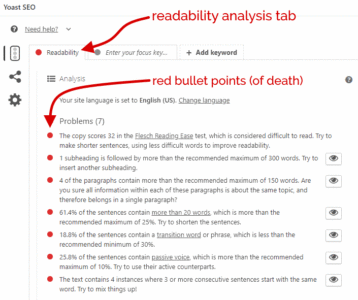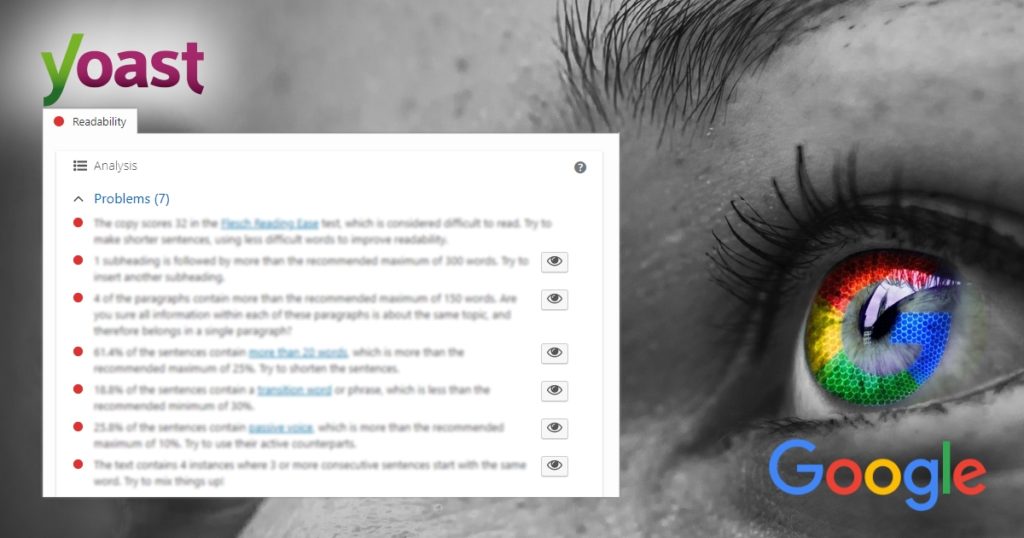Hours pass and you’re still editing your post — desperate to turn every bullet point on Yoast SEO’s readability tab, green. Nothing less! Must outrank the big guns on Google. Need more search traffic.
Yet, you don’t even know if obsessing over the readability score really helps with your search rankings.
Think about it…
- Does a full score of green bullets mean your content is easy to read?
- Does Google even use Yoast SEO’s readability standards?
- Is manipulating the score more important than resonating with your human readers?
In this post, discover 10 real web page examples that get at least one red bullet… but still rank on the first page of Google SERP (search engine results page)!

Readability for humans, search engines, and Yoast SEO
Reading ease for humans

Readability measure how easy it is for a person to read and digest a piece of content. It considers both the complexity (e.g. use of jargon, choice of sentence structure) and presentation of the content (e.g. typography, layout).
If a person takes too long to read your post — either due to poorly structured content or layout clutter — your content is deemed hard-to-read.
Readability for search engines

Search users exit websites that are irrelevant to their search and/or hard to read.
If someone has to spend minutes just to figure out if your content is relevant, they move on to the next result.
This explains why Google’s algorithm rewards easy-to-read web pages with higher search rankings.
That said, reading ease is subjective. It depends on your target readers’ education, expertise, and industry.
Read this for the list of potential readability ranking signals used by Google.
Readability for Yoast SEO

Used by over 5 million websites, Yoast SEO is the top WordPress plugin for SEO. It adds an analysis panel to your post/page editor, with feedback about the content readability and SEO focus keyword.
On the readability tab, Yoast rates your content with colour-coded bullet points and suggestions — red indicates a serious problem; orange shows some room for improvement; green is good.
Yet, Yoast’s readability analysis has limits…
Yoast ignores how content is presented:

Yoast gauges readability based on content complexity alone. It ignores how content is presented (e.g. layout and typography), which is a huge factor in readability.
Yoast has no idea how Google gauges reading ease:
Like the rest of us, Yoast has no idea how Google’s algorithm measures a web page’s readability.
Yoast oversimplifies readability best practices:
Yoast quantifies readability best practices into its formula and oversimplifies how actual people read. It doesn’t consider exceptions.
Don’t get me wrong. Yoast’s feedback is backed by solid data. The problem, however, occurs only when writers become a slave to green bullet points and lose sight of what is important — resonating with target readers.
Yoast SEO’s Readability Analysis factors (with 10 real examples breaking the “rules”)
What are Yoast’s readability factors? And when should you ignore the red or orange bullet points?
For each readability factor, I’ll show you an example of a real web page that goes against Yoast’s bullet warning. Make sure to zoom in on the screenshot.
I’ve also included Facebook engagement stats and search rankings (without revealing the specific search keyword) of all website examples.
#1 Flesch Reading Ease Test

Yoast’s advice:
To get the green bullet, your content has to get a Flesch Reading Ease test score of 60 and above. A score under 60 to the lowest of 50 gets the orange bullet; anything under 50 gets the dreaded red bullet.
Reason:
People on the web are notorious for scanning content. Most prefer easy-to-read posts. The Flesch Reading Ease test determines how complex a content copy is and scores it on a scale of 0 to 100 (see table below).
| Score | School-level | Notes |
|---|---|---|
| 100.00-90.00 | 5th grade | Very easy to read. Easily understood by an average 11-year-old student. |
| 90.0–80.0 | 6th grade | Easy to read. Conversational English for consumers. |
| 80.0–70.0 | 7th grade | Fairly easy to read. |
| 70.0–60.0 | 8th & 9th grade | Plain English. Easily understood by 13- to 15-year-old students. |
(Source: Wikipedia)
Limitations:

The Flesch Reading Ease test oversimplifies readability and is, as such, an inaccurate measure. The formula calculates complexity based only on two factors:
- the average number of syllables per word (multisyllabic words penalised)
- the average number of words per sentence (long sentences penalised)
Long sentences and words with more than one syllable are not always hard to understand. But the Flesch-Kincaid formula penalises both. What’s more… there is no proof that Google uses Flesch to determine readability.
When to ignore the Flesch Reading Ease bullet [Examples: Hootsuite & Way Of Ninja]
Ignore when using numerous multisyllabic words

Consider the words, “interesting”, “watermelon”, “ingredients”, “society”, and “imagination”. Using them lowers your Flesch Reading Ease score.
These words are common in English but get zero solely due to the number of syllables — more than two syllables.
While “green spheroid fruit with black stripes” will earn you points with Flesch, just use the word “watermelon”.
Don’t avoid simple multisyllabic words just to get a green bullet. It makes your writing awkward and turns your readers off.
Ignore when using industry-specific terms (that your target readers understand)
[Example] — 6 Brand Certifications to Make You a Better Social Media Marketer
- Yoast [Flesch]: 47 — failed due to numerous multisyllabic marketing terms
- SERP Ranking: Page one
- FB Engagement: 6,391
![Example: 6 Brand Certifications to Make You a Better Social Media Marketer [Hootsuite, Kaylynn Chong] -- Flesch Reading Ease Score: 47 (failure due to technical terms)](http://logenlanka.com/wp-content/uploads/2018/04/Hootsuite-Flesch-industry-terms-671x385.jpg)
But, there is really no problem with readability! The post is easy to digest for both marketers and business owners. In fact, it’s doing well on both Google and Facebook.
So ignore the red/orange bullet.
Always consider your target readers and their industry. If they resonate with industry terms, use them. Don’t deliberately make edits to manipulate your Flesch score. Dumbing down content can cost you new clients.
Ignore when using transliterated terms and names
[Example] — Where can I learn ninjutsu of the real ninja?
- Yoast [Flesch]: 29.9 — failed due to numerous transliterated Japanese terms and names
- SERP Ranking: Page one
- FB Engagement: unknown (original URL changed; old FB stats lost)
![Example: Where can I learn ninjutsu of the real ninja? [Way Of Ninja, Logen Lanka] -- Flesch Reading Ease Score: 29.9](http://logenlanka.com/wp-content/uploads/2018/04/Way-Of-Ninja-Transliterated-name-terms-671x385.gif)
This post I wrote included long transliterated terms and names in Japanese. I had to use them for the content to be informative (names of instructors and organizations, and terms in Japanese martial arts with unique meanings).
Omitting the terms would have made the post pointless. But Yoast SEO penalised the content for the multisyllabic transliterated words and correspondingly long sentences.
The high rankings on Google (and old social stats) suggest that enough people read the content with no problems. Again, ignore the red/orange bullet in such a situation.
Ignore false flags: Long References, HTML code, and WordPress shortcodes
[Example] — Where can I learn ninjutsu of the real ninja?
- Yoast [Flesch]: 29.9 — failed due to lengthy citations with multisyllabic titles (false flag)
- SERP Ranking: Page one
- FB Engagement: unknown (original URL changed, old FB stats lost)
![Example: Where can I learn ninjutsu of the real ninja? [Way Of Ninja, Logen Lanka] -- Flesch Reading Ease Score: 29.9](http://logenlanka.com/wp-content/uploads/2018/04/Way-Of-Ninja-Citations-671x385.gif)
If you include long references at the end of your post, it will affect your Flesch score.
Refer to the same Way Of Ninja example. It contain citations within a WordPress shortcode.
Flesch penalises citations that contain 20 words before the full stop (i.e. period) as they are mistaken for sentences. Likewise, references that include three (or more) syllable words.
The same goes for HTML tables with huge datasets.
Ignore when long sentences are appropriate
Refer to #2 — Too many long sentences.
#2 Too many long sentences

Yoast’s advice:
To get a green bullet, limit long sentences to no more than 25% of your total sentences in a post. How long is long? Sentences with more than 20 words.
Reason:
People tend to lose track of your point when reading an overly long sentence. This causes them to re-read the same sentence, which can induce eye fatigue.
Limitation:
But, posts made up of only short sentences are sometimes HARD-to-read. Breaking ideas into shorter sentences can interrupt reading flow. The monotony of endless short sentences can also affect attention span. So moderation of sentence length is crucial.
When to ignore the “shorten the sentences” bullet [Examples: Hubspot & Business 2 Community]
Ignore when your writing style involves long sentences and quoted sources
[Example] — 16 of the Best Shopify Stores to Inspire Your Own
- Yoast [long sentences]: 47.8% of the sentences contain more than 20 words — failed
- SERP Ranking: Page one
- FB Engagement: 69 (recently published – 3 April 2018)
![Example: 16 of the Best Shopify Stores to Inspire Your Own [Hubspot, Caroline Forsey] -- 47.8% of sentences contain more than 20 words](http://logenlanka.com/wp-content/uploads/2018/04/Hubspot-Long-sentences-671x368.jpg)
Her writing style and quoted statements (from several Shopify stores) contribute to the length of her sentences.
If you’re quoting someone or naturally write longer sentences, ignore the orange/red bullet. But use punctuation to make those sentences easy to understand.
Ignore when writing technical or complicated topics
[Example] — How to Get the Best Results with Google AdSense Video Ads
- Yoast [long sentences]: 37.7% of the sentences contain more than 20 words — failed
- SERP Ranking: Not found in the top 100 (recently published – 1 April 2018)
- FB Engagement: negligible (recently published – 1 April 2018)
![Example: How to Get the Best Results with Google AdSense Video Ads [B2C, Ana Gotter] -- 37.7% of sentences contain more than 20 words](http://logenlanka.com/wp-content/uploads/2018/04/B2C-long-sentences-671x363.jpg)
But, look at my attempt to do so below. The idea feels interrupted.
“In Adsense, however, your ad groups will utilize audience interest to determine ad placement. They will also use active intent in researching certain products and past relationships with your site to determine ad placement. ”
Long sentences can often express complicated ideas without breaking flow. This aids in the reader’s understanding.
So ignore the red/orange bullet if a long sentence conveys your thoughts better than a few short ones. Proper punctuation will make it readable.
Ignore false flags — Long References, HTML code, and WordPress shortcodes
Refer to #1 — Flesch Reading Ease Test. The false flags are the same.
#3 Subheading followed by too many words

Yoast’s advice:
To get a green bullet, limit the content to no more than 300 words for every subheading.
Reason:
Subheadings let readers scan and know the gist of your content. Keeping the word-count short under each subheading makes it convenient for the reader to scroll back (if they forget your sub-point).
Limitation:
But, subheadings aren’t the only way to section content and make it scannable.
When to ignore “insert another subheading” bullet [Examples: Popular Chips Daily & Pottermore]
Ignore when you include visual references (i.e. images, charts, videos, social embeds)
[Example] — Was the #SGBudget2018 Campaign Effective? Let the Data Speak.
- Yoast [subheadings]: 2 subheadings followed by over 300 words — failed
- SERP Ranking: Unknown (searches for this one-off event has diminished)
- FB Engagement: 131 — good
![Example: Was the #SGBudget2018 Campaign Effective? ? Let the Data Speak. [Popular Chips Daily, Rachel Lee] -- Subheadings followed by more than 300 words](http://logenlanka.com/wp-content/uploads/2018/04/popchips-300-words-after-subheadings2-671x345.jpg)
Even though she goes over 300 words after each subheading, the images (inserted amongst the text) give your eyes a point of reference — just like subheadings do.
This is the presentation aspect of readability that Yoast SEO ignores…
![Example: Was the #SGBudget2018 Campaign Effective? ? Let the Data Speak. [Popular Chips Daily, Rachel Lee] -- Plenty of charts and photos](http://logenlanka.com/wp-content/uploads/2018/04/Pop-chips-360x296.jpg)
Ignore when you’re writing a short story
[Example] — Ilvermorny School of Witchcraft and Wizardry
- Yoast [subheadings]: 6 subheadings followed by over 300 words of content — failed
- SERP Ranking: Page one (top position)
- FB Engagement: 72,667 (see for yourself!)
![Example: Ilvermorny School of Witchcraft and Wizardry [Pottermore, J.K. Rowling] -- Subheadings followed by more than 300 words](http://logenlanka.com/wp-content/uploads/2018/04/pottermore-subheadings-671x357.jpg)
The backstory of the American wizarding school got nearly 73 thousand shares and likes on Facebook! And it is found at the top of Google’s search results for a relevant keyword query.
First, subheadings make little sense for short works of fiction, even in the form of a blog post. Next, if you do use them, it’s okay to go way beyond Yoast’s 300-word limit for each subheading.
Go ahead and ignore the red or orange bullet.
#4 Sentence beginnings — same word at the start of consecutive sentences

Yoast’s advice:
To get a green bullet, your content shouldn’t have three (or more) consecutive sentences that begin with the same word.
Reason:
Consecutive repetition of sentence beginnings makes a post annoying to read.
Limitation:
Sometimes, repetition helps the reader with understanding and content resonance.
When to ignore the “3 or more consecutive sentences” bullet [Example: Buffer]
Ignore when emphasising a point

It’s okay to repeat sentence beginnings to emphasise a point, especially as an introductory hook. It can help readers relate to your content emotionally.
Ignore when making lists separated by bullets or semicolons
[Example] — The New Facebook Algorithm: Secrets Behind How It Works and What You Can Do To Succeed
- Yoast [same beginnings]: 4 consecutive sentences starting with the same word
- SERP Ranking: Page one (top position)
- FB Engagement: 4,979
![Example: The New Facebook Algorithm: Secrets Behind How It Works and What You Can Do To Succeed [Buffer, Brian Peters] -- Consecutive sentences that begins with the same word](http://logenlanka.com/wp-content/uploads/2018/04/Buffer-consecutive-sentences-2-671x385.jpg)
No. “What” serves a legitimate purpose here. It also draws attention to the questions readers need to reflect on.
Keep in mind that Brian’s post was the most widely-shared article on Buffer in the past year.
#5 Not enough transition words (or phrases)

Yoast’s advice:
To get a green bullet, use a transition word or phrase in at least 30% of your total sentences.
Reason:
Transition words and phrases — like “most importantly”, “firstly”, “therefore”, “due to”, “perhaps” and “above all” — make your content flow better. They connect concepts and allows the reader to anticipate the next sentence (or paragraph). This helps the reader process concepts quicker.
Limitations:
Yoast SEO plugin factors in only a limited list of transition words/phrases. Using anything else won’t be counted in your score. Also, deliberately using transition words/phrases — when they don’t fit — makes your content clunky.
Lastly, there is a category of transition words called fuzzy signals that make your content sound unsure and less credible. These are words like “perhaps”, “maybe”, and “probably”.
When to ignore the “transition word or phrase” bullet [Example: MINDBODY Online]
Ignore when writing sales or product copy
[Example] — Yoga studio software, MINDBODY
- Yoast [transition word]: 13% of sentences contain a transition word/phrase, which isn’t enough to pass.
- SERP Ranking: Page one
- FB Engagement: 868
![Example: Yoga Management Software [MINDBODY] -- Not enough transition words](http://logenlanka.com/wp-content/uploads/2018/04/MINDBODY-Yoga-Management-Software-Transition-words-671x344.gif)
Adding transition words and phrases would impede conversions in this case. That’s the opposite of what readable content is supposed to do.
After all, MindBody’s landing page is on page one of Google SERP for a non-branded keyword.
Ignore the orange/red bullet for your copywriter’s sake!
#6 Excessive passive voice

Yoast’s advice:
To get a green bullet, limit the use of passive voice to no more than 10% of total sentences in your post. Use active voice for the rest of your content.
Reason:
It is more intuitive to process an active voice sentence structure than passive. That’s because the active voice expresses the sequence of events in a straightforward manner. The sentence begins with the doer, followed by the doer’s action, and then the doer’s target.
Moreover, the passive voice sounds impersonal and wordy.
| Passive | Active |
|---|---|
| “The use of passive voice is limited to no more than 10% of total sentences in a post by Yoast.” (with the doer, “Yoast”)
or “The use of passive voice is limited to no more than 10% of total sentences in a post.” (without the doer) |
“Yoast limits the use of passive voice to no more than 10% of total sentences in a post.” |
Limitations:
The active voice isn’t always the best choice for all types of content.
When to ignore the “passive voice” bullet [Examples: English Heritage & Yocale]
Ignore when you have no information about the doer
[Example] — STONEHENGE, English Heritage
- Yoast [passive voice]: 19% of sentences contain passive voice
- SERP Ranking: Page one
- FB Engagement: 3,236
![Example: STONEHENGE [English Heritage, HISTORY OF STONEHENGE section] -- Use of passive voice](http://logenlanka.com/wp-content/uploads/2018/04/English-Heritage-passive-660x385.gif)
| Passive | Active |
|---|---|
| “It was built in several stages” (quoted from English Heritage) | “Early humans (presumably) built it in several stages” (active voice edit of English Heritage’s original quote) |
Forcing yourself to use active voice means speculating who built the Stonehenge. Also, the active voice emphasizes the builders rather than the point that it was built in stages.
Ignore when the doer is not important
| Passive | Active |
|---|---|
| “All cadets are required to assemble at the courtyard at 5.00 am.” | “The Military Academy requires all cadets to assemble at the courtyard at 5.00 am.” |
| “The participants were then asked to complete a survey after the 15-minute running test.” | “Harvard researchers then asked the participants to complete a survey after the 15-minute running test.” |
Ignore when the emphasis is on the target (and not the doer)
- Yoast [passive voice]: 4.1% of sentences contain passive voice — green bullet
- SERP Ranking: Unknown
- FB Engagement: negligible
![Our Team [Yocale Business, Arash Asli section] -- Use of passive voice](http://logenlanka.com/wp-content/uploads/2018/04/Yocale-passive-voice-671x385.jpg)
Do note that the poor SERP rankings and social stats are normal for pages about the staff. Most people rarely search or share that information.
| Passive | Active |
|---|---|
| “Arash is honored to have been named the Business in Vancouver’s Top Forty under 40 business executive.” (quoted from Yocale Business) | “Vancouver’s Top Forty under 40 named Arash as one of the business executives in its list.” (active voice edit of Yocale Business’ original quote) |
| “If you’ve been injured by the defective product, please contact us for a free legal consultation.” | “If the defective product injures you, please contact us for a free legal consultation.” |
While both examples mean the same thing, there are nuanced differences in what each implies. The passive voice puts the injured customer first; the active voice implies that the customer’s injury is a secondary concern.
Likewise, in the Yocale example, the CEO, Arash, is the focus.
Ignore when the statement is a general truth
| Passive | Active |
|---|---|
| “Rules are made to be broken” | (not even going to try) |
#7 Long Paragraphs

Yoast’s advice:
To get a green bullet, limit every paragraph to no more than 150 words.
Reason:
Walls of text scare readers (and scanners) away. Besides, people tend to backtrack while reading because there isn’t a visible line-break in a long paragraph that acts as a point of reference. This makes the reading experience tiring.
When to ignore the long paragraph bullet [No examples]

Few situations warrant a paragraph of more than 150 words (especially when writing on the internet). Even academic and literary blogs benefit from shorter paragraphs.
Ignore false flags: WordPress Shortcodes with lengthy datasets
Again, Yoast regards long content within certain WordPress Shortcodes (especially if you’re using custom plugins) as a full paragraph. Ignore the red bullet in such a situation.
The bottom line

Even though Yoast SEO’s readability analysis gives feedback based on best practices, it has limits. There is no need to get all bullets to turn green.
If you have no experience in writing for the web, Yoast’s advice can be helpful. And if you’re suffering from fatigue, it points out common Reading Ease faults, which helps you with editing.
However, never become a slave to the green bullet points!
I’ve shown examples — Hubspot, Hootsuite, Way Of Ninja, and more — that took one to two red/orange bullet(s) in the chest. Most of them rank high on Google and are widely shared on Facebook. That’s because these sites focus on easy-to-read content that fits their target reader’s interests, education, and industry.
No doubt, search rankings fluctuate due to a large list of factors (e.g. backlinks, site speed, and more). But, easy-to-read content is among the most important factors that help search users decide if your web page is relevant.
So if you insist on getting a perfect Yoast score — at the cost of actual readability — neither your readers nor Google will reward you for it.
Lastly, if you’ve hired a competent copywriter and content writer, trust them to bend the “rules”.
Above all, let your content resonate with your readers, NOT Google. Use Yoast’s readability bullet points only as a guide!



Great post and tthank you for breaking this Down, plenty of people get a headache when they see a red bullet 🙂